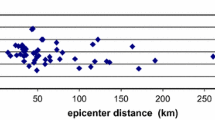Abstract
A new procedure for combining the response spectra of two horizontal components of recorded ground motion is presented. The presented formulation accounts for different orientations of accelerometer sensors and derives the maximum and the expected (mean) horizontal response spectra at a site, both of which are invariant to rotation of sensor axes. The maximum response spectrum is derived as the peak resultant response of single degree of freedom oscillators subjected to the as-recorded ground acceleration. The expected spectrum is derived by projecting the displacement response (due to as-recorded motion) along two orthogonal axes to a principal axes in which the displacement responses are uncorrelated. This property is used to formulate an approximation for the expected response spectrum over all possible sensor orientations. A large set of accelerometric data from Europe and the Middle East is used to demonstrate the applicability of the proposed response spectral measures.




Similar content being viewed by others
References
Abdi H, Williams LJ (2010) Principal component analysis. Wiley Interdiscip Rev Comput Stat 2:433–459
Ambraseys NN, Douglas J, Sigbjörnsson R, Bergy-Theirry C, Suhadolc P, Costa G, Smit PM (2004) Dissemination of European strong-motion data, vol 2, using strong-motion datascape navigator, CD ROM collection. Engineering and Physical Sciences Research Council, UK
Beyer K, Bommer JJ (2006) Relationships between median values and between aleatory variabilities for different definitions of the horizontal component of motion. Bull Seismol Soc Am 96(4):1512–1522
Boore DM (2010) Orientation-independent, nongeometric-mean measures of seismic intensity from two horizontal components of motion. Bull Seismol Soc Am 100(4):1830–1835
Boore DM, Watson-Lamprey J, Abrahamson NA (2006) Orientation-independent measures of ground motion. Bull Seismol Soc Am 96(4A):1502–1511
Douglas J (2003) Earthquake ground motion estimation using strong-motion records: a review of equations for the estimation of peak ground acceleration and response spectral ordinates. Earth-Sci Rev 61:43–104
Vanmarcke EH (1975) On the distribution of the first-passage time for normal stationary random processes. J Appl Mech 42:215–220
Acknowledgments
We acknowledge the support from University of Iceland Research Fund. This work has been co-financed by the European project “Urban Prevention Strategies using Macroseismic and Fault sources” (UPStrat-MAFA–Num. 230301/2011/613486/SUB/A5), DG ECHO Unit A5. Support from the Energy Research Fund of Landsvirkjun, the national power company of Iceland, is acknowledged.
Author information
Authors and Affiliations
Corresponding author
Rights and permissions
About this article
Cite this article
Rupakhety, R., Sigbjörnsson, R. Rotation-invariant measures of earthquake response spectra. Bull Earthquake Eng 11, 1885–1893 (2013). https://doi.org/10.1007/s10518-013-9472-1
Received:
Accepted:
Published:
Issue Date:
DOI: https://doi.org/10.1007/s10518-013-9472-1




